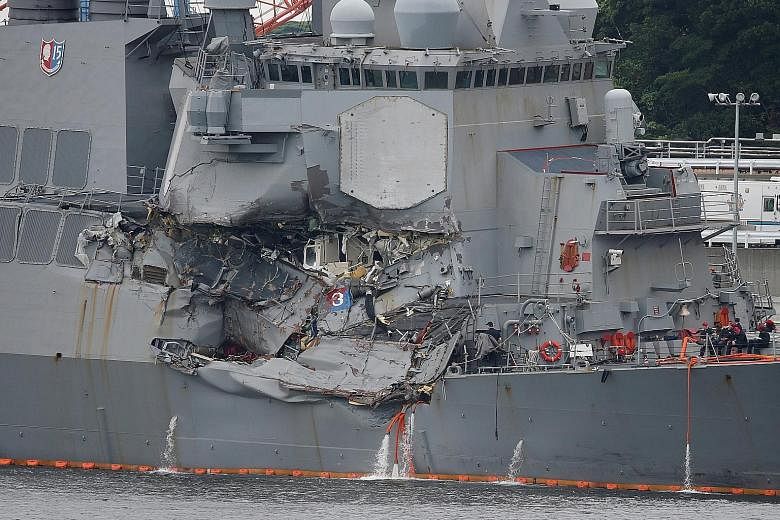WASHINGTON • After a string of deadly accidents in the western Pacific, a top admiral has acknowledged that the US Navy had knowingly operated warships in the region despite a growing number of major training and maintenance shortfalls - all to meet increasing operational demands.
An unusual hearing of two House armed services subcommittees on Thursday offered no new information about what caused four US Navy incidents in the western Pacific this year, including two fatal collisions between navy destroyers and foreign cargo ships that left 17 sailors dead. Those accidents remain under investigation.
But the hearing painted a disturbing portrait of fatigued crews and commanders on a shrinking overseas fleet saddled with constant deployments - including confronting an expansionist Chinese military and keeping vigil over a nuclear sabre-rattling North Korea - with little time left to train or to repair ageing ships.
"The navy is caught between unrelenting demands and a shortage of ships," Mr John Pendleton, a director of the Government Accountability Office, the investigative arm of Congress, told lawmakers. The office has chronicled the navy's woes in several recent reports.
Contrite navy officials conceded that they had accepted increasing risks with uncertified ships and crews, despite repeated warnings from congressional watchdogs and the navy's own experts.
In case after case, US Navy ship commanders and their chains of command approved waivers to expiring certifications of standards so long as temporary measures were put in place to mitigate the risks.
"We have allowed standards to drop as the number of certifications has grown," said Admiral William Moran, the vice-chief of naval operations, referring to waivers of required tests certifying navy crews and ships had met certain standards, such as seamanship.
As of June, 37 per cent of the certifications for the crews of cruisers and destroyers based at the Seventh Fleet in Yokosuka, Japan, had expired, Mr Pendleton said. That was more than a fivefold increase in the percentage of expired certifications for the crews of those ships since a Government Accountability Office report in May 2015, he said.
Thursday's hearing was the first time that US Navy officials had publicly responded to Congress since the destroyer John S. McCain collided last month with an oil tanker off the coast of Singapore, killing 10 sailors. In June, the destroyer Fitzgerald collided with a cargo ship off Japan. Seven sailors died in their flooded berthing compartments.
After the McCain crash, the US Navy relieved the commander of the Seventh Fleet, Vice-Admiral Joseph Aucoin, and directed all 277 navy ships worldwide to suspend operations for a day or two to examine basic seamanship and teamwork. It also ordered a comprehensive review of fleet operations, training and manning to be completed within 60 days.
-
37%
Of certifications for the crews of cruisers and destroyers based at the Seventh Fleet in Yokosuka, Japan, had expired as of June - a more than fivefold increase in the percentage of expired certifications since 2015.
-
20%
Fewer navy ships are in operation today than in 2015. However, the time they are deployed has remained the same.
Lawmakers, however, seemed unsatisfied that the navy was taking adequate immediate measures to prevent another accident, and demanded to know why the navy did not pause its operations after the Fitzgerald crash. "It should have," Admiral Moran said.
Even as the US Navy has shrunk, its missions have grown to meet demands in a region that has become increasingly unstable.
In the past two decades, the number of US Navy ships has fallen about 20 per cent, though the time they are deployed has stayed the same, according to a 2015 report by the Centre for Strategic and Budgetary Assessments, a Washington research group funded by the Defence Department. The increased burden has fallen disproportionately on the Seventh Fleet.
NYTIMES

